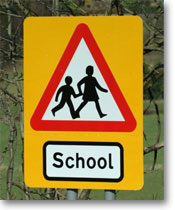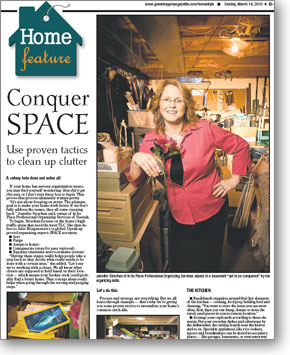When Abby and Chester Shaffer get home, they know where to put their coats, shoes and other items in a room off the garage.
“They each have their own spots,” said mom Katy, 31, of Neenah, who has a 7-month-old daughter in addition to Chester, 2 and Abby, 4.
In the house, many of the kids’ items, from back packs to toys, have designated spots, which often eliminates the need for a search and rescue mission for missing articles.
“I explain that they need to put them back there so that when they want them again they know where they are,” Shaffer said.
Her children are learning skills such as responsibility, stewardship and cleanliness, skills that are helpful now and later down the road.
“(It) teaches them responsibility and prepares them for life to be self-sufficient,” she said.
Shaffer grew up learning similar skills.
“My mom always had a place for all our stuff, and I remember growing up being told if you can’t find a place for it, then you must not need it,” she said.
The added benefit to raising organized children is that it helps to cut down on some of the stress in the house, Shaffer said.
“I am a very organized person, usually, and when there is a great deal of chaos I get frazzled,” she said, adding that having an organization effort in place “helps me remain calm too and allows for more time to do other things instead of wasting time looking for things or picking up after them or retelling them the basics they need to do every day.”
Start them off young
Organizational traits can begin at an early age and follow through adulthood, said Lea Schneider of Pensacola, Fla., a professional organizer and owner of organizerightnow.com.
“You are not born organized,” said Schneider, author of Growing-Up Organized: A Mom-to-Mom Guide. “You learn to be organized.”
Children model from their parents, even in areas of organization, she said, noting that parents should take time to give their children an lesson in organization.
“Instead of just fussing, explain why organizing the project, space or time will make their life easier,” Schneider said. “Demonstrate how to do it. Practice with them. Give them steps they can follow and then stand back and just supervise.”
Tackle one Thing at a Time
With busy lives, families can be lost as to where and how to begin with teaching organization, Schneider said.
That was one reason behind her book. As a mom, she knows how crazy things get when she tries to do it all for her family.
“As a professional organizer, I’ve been in lots of homes and often found myself making the same suggestions over and over,” she said. “I realized there are lots of moms looking for solutions.”
Schneider recommends tackling one area at a time.
“You can’t decide you want everything changed immediately,” she said. “That would be too overwhelming for both you and the children.”
Instead, pick what needs the most work, be it a routine to clean rooms or peaceful homework time.
Once a goal has been set, “sit down with the kids and tell them your goal,” Schneider said.
And then get the kids involved with the process.
“Ask them for ideas and take the time to listen and incorporate them as you much as you can,” she said. “The more you bring them on board, the more success you will see.”
Be Flexible and Look at the Big Picture
Teaching a child to be organized also requires some flexibility, said Jennifer Strachan, a professional organizer and owner of In Its Place Organizing Services in Neenah.
“Whatever the system is, try to make it a flexible system,” she said. “As your children grow, so do their needs and wants change.”
For instance, when her daughter was a child, Strachan converted a small space in the basement into a dress-up area.
“I really wanted to have a divided space so she knows this is where your stuff is supposed to go,” she said.
But by looking ahead, Strachan decided to put in shelves that could be used for other storage in the future.
“It has worked out great,” she said.
Be Age Appropriate
When starting with young children, consider simple tasks such as putting socks in drawers and putting clean spoons into the drawer, Schneider said. Children also can help label their toy bins with pictures.
“Very young children can begin to organize physical space by learning each thing has a home,” Schneider said.
For older children, they “can learn time management,” she said.
“Doing so, they will learn how to allocate time for sports, practices, activities, homework and chores,” she said. “Often, parents will ask them over and over to do something and they get a response of ‘later.’ This is because they can’t see the big picture of ‘later.’ Teach them how to do just that.”
Keep it Simple
The key to keeping lids on an organized-minded track is to keep instructions simple for them, Strachan said.
“You have to keep things pretty simple and easy to get to and easy to use for them to want to maintain it or they will stop doing it,” she said.
Job charts listing specific tasks are one way to help kids know exactly what they need to do.
“That can be a brain saver for Mom and Dad,” Strachan said. “Some kids just do better with reading versus listening.”
Schneider said a wipe-off board is handy for readers.
“For non-readers, you can use a picture list,” she said. “They can check off the list. This teaches them to think ahead plus to be responsible for their own belongings and time.”
Strachan uses a spiral-bound notebook, each with the names of the children. Inside are items that need to get done.
“It’s so freeing to me because I’m not worried and I will look at that sheet,” she said. “I think that kind of gets their attention. I don’t need to be constantly reminding (them).”
However, as children get used to an organization system, repetition will be needed, Strachan said.
“Don’t expect your children to figure it out the first or second time,” she said.
Stick With It
The road to an organized child may have bumps and detours but in the long run, your children will appreciate the skills they learned.
“They’re going to be on their own at some point in time,” Strachan said. “It’s not going to get anywhere if I’m doing it. I think they need to have responsibility.”
Schneider agreed.
“Teaching your child to organize their belongings, their space and their time will benefit them through school and into the workplace,” she said. “It seems to me nearly every employer in every field lists organized as a required job skill.”
Moms also can let go of the need to do it all, Schneider said.
“Being part of a family means not only embracing the joys of family life but participating in family life,” she said. “Children can and should learn how to participate in keeping the house organized and manage their own time and own belongings. It’s all part of being a family. The lessons your child learns from you will be a gift they take with them their whole lives.”
By Linda Dums • For The Post-Crescent


 School’s out!! If you stop by your child’s school it will look bare, cleaned out. That’s because every child’s home now has 12.5 inches more stuff in it per child!!! At least it feels like it doesn’t it? What happens to that pile? If you’re lucky, it stays neatly in the backpack until your angel systematically separates everything out and shares all their earthly goods with you and then get rids of most of it. Yeah right!
School’s out!! If you stop by your child’s school it will look bare, cleaned out. That’s because every child’s home now has 12.5 inches more stuff in it per child!!! At least it feels like it doesn’t it? What happens to that pile? If you’re lucky, it stays neatly in the backpack until your angel systematically separates everything out and shares all their earthly goods with you and then get rids of most of it. Yeah right!